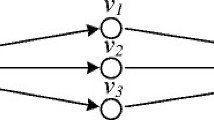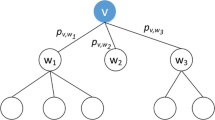Abstract
Influence maximization (IM) problem for messages propagation is an important topic in mobile social networks. The success of the spreading process depends on the mechanism for selection of the influential user. Beside selection of influential users, the computation and running time should be considered in this mechanism to ensure the accurecy and efficient. In this paper, considering that the overhead of exact computation varies nonlinearly with fluctuations in data size, random algorithm with smoother complexity change was designed to solve the IM problem in combination with greedy algorithm. Firstly, we proposed a method named two-hop neighbor network influence estimator to evaluate the influence of all nodes in the two-hop neighbor network. Then, we developed a novel greedy algorithm, the random walk probability cost-effective with lazy-forward (RWP-CELF) algorithm by modifying cost-effective with lazy-forward (CELF) with random algorithm, which uses 25–50 orders of magnitude less time than the state-of-the-art algorithms. We compared the influence spread effect of RWP-CELF on real datasets with a theoretically proven algorithm that is guaranteed to be approximately optimal. Experiments show that the spread effect of RWP-CELF is comparable to this algorithm, and the running time is much lower than this algorithm.






Similar content being viewed by others
References
Hu X, Chu THS, Leung VCM, Ngai CH, Philippe K, Chan HCB (2015) A survey on mobile social networks: applications, platforms, system architectures, and future research directions. IEEE Commun Surv Tutor 17(3):1557–1581
Chen W, Wang C, Wang Y (2010) Scalable influence maximization for prevalent viral marketing in large-scale social networks. In: Proceedings of the 16th ACM SIGKDD international conference on knowledge discovery and data mining, pp 1029–1038
Budak C, Agrawal D, Abbadi AE (2011) Limiting the spread of misinformation in social networks. In: Proceedings of the 20th international conference on World wide web, pp 665–674
Domingos P, Richardson M (2001) Mining the network value of customers. In: Proceedings of the 7th ACM SIGKDD international conference on knowledge discovery and data mining, pp 57–66
Zhang P, Bao Z, Niu Y, Zhang Y, Mo S, Geng F, Peng Z (2019) Proactive rumor control in online networks. World Wide Web 22(4):1799–1818
Li Y, Wang Y, Tan KL (2018) Influence maximization on social graphs: a survey. IEEE Trans Knowl Data Eng 30(10):1852–1872
Kempe D, Kleinberg J, Tardos É (2003) Maximizing the spread of influence through a social network. In: Proceedings of the 9th international conference on knowledge discovery and data mining, pp 137–146
Banerjee S, Jenamani M, Pratihar DK (2020) A survey on influence maximization in a social network. Knowl Inf Syst 62(9):3417–3455
Banerjee S, Jenamani M, Pratihar DK (2022) An approximate marginal spread computation approach for the budgeted influence maximization with delay. Computing 104:657–680
Raghavan S, Zhang R R (2015) Weighted target set selection on social networks, Technical report, Working paper, University of Maryland
Azaouzi M, Mnasria W, Romdhane LB (2021) New trends in influence maximization models. Comput Sci Rev 40:100393
Zhu T, Wang B, Wu B, Zhu C (2014) Maximizing the spread of influence ranking in social networks. Inform ci 278:535–544
Srivastava A, Chelmis C, Prasanna VK (2014) Influence in social networks: a unified model? In: Proceedings of the IEEE/ACM international conference on advances in social networks analysis and mining, pp 451–454
Mohamadi-Baghmolaei R, Mozafari N, Hamzeh A (2015) Trust based latency aware influence maximization in social networks. Eng Appl Artif Intell 41:195–206
Wang F, Wang G, Xie D (2016) Maximizing the spread of positive influence under LT-MLA model. In: Asia-Pacific services computing conference, pp 450–463
Leskovec J, Krause A, Guestrin C, Faloutsos C, Vanbriesen J, Glance N (2007) Cost-effective outbreak detection in networks. In: Proceedings of the 13th ACM SIGKDD international conference on Knowledge discovery and data mining, pp 420–429
Goyal A, Lu W, Lakshmanan LVS (2011) CELF++: optimizing the greedy algorithm for influence maximization in social networks. In: Proceedings of the 20th international conference companion on World wide web, pp 47–48
Chen W, Wang Y, Yang S (2009) Efficient influence maximization in social networks. In: Proceedings of the 15th ACM SIGKDD international conference on Knowledge discovery and data mining, pp 199–207
Kundu S, Pal SK (2015) Deprecation based greedy strategy for set selection in large scale social networks. Inf Sci 316:107–122
Shang J, Zhou S, Li X, Liu L, Wu H (2017) CoFIM: a community-based framework for influence maximization on large-scale networks. Knowl-Based Syst 117:88–100
Lu F, Zhang W, Shao L, Jiang X, Xu P, Jin H (2016) Scalable influence maximization under independent cascade model. J Netw Comput Appl 86:15–23
Freeman LC (1978) Centrality in social networks conceptual clarification. Soc Netw 1(3):215–239
Newman MJ (2005) A measure of betweenness centrality based on random walks. Soc Netw 27(1):39–54
Gao M, Xu L, Lin L, Huang Y, Zhang X (2020) Influence maximization based on activity degree in mobile social networks. Concurr Comput Pract Exp. https://doi.org/10.1002/cpe.5677
Zhang X, Xu L, Gao M (2020) An efficient influence maximization algorithm based on social relationship priority in mobile social networks. In: International Symposium on Security and Privacy in Social Networks and Big Data. Springer, pp 164–177
Jiang Q, Song G, Cong G, Wang Y, Si W, Xie K (2011) Simulated annealing based influence maximization in social networks. In: Proceeding of the 25th AAAI conference on artificial intelligence, pp 127–132
Cui L, Hu H, Yu S, Yan Q, Ming Z, Wen Z, Lu N (2018) DDSE: a novel evolutionary algorithm based on degree-descending search strategy for influence maximization in social networks. J Netw Comput Appl 103:119–130
Gong M, Yan J, Shen B, Ma L, Cai Q (2016) Influence maximization in social networks based on discrete particle swarm optimization. Inf Sci 367–368(C):600–614
Tang J, Zhang R, Wang P, Zhao Z, Fan L, Liu X (2020) A discrete shuffled frog-leaping algorithm to identify influential nodes for influence maximization in social networks. Knowl-Based Syst 187:104833
Zhang X, Zhu J, Wang Q, Zhao H (2013) Identifying influential nodes in complex networks with community structure. Knowl-Based Syst 42:74–84
Shang J, Zhou S, Li X, Liu L, Wu H (2017) CoFIM: a community-based framework for influence maximization on large-scale networks. Knowl-Based Syst 117:88–100
Shang J, Wu H, Zhou S, Zhong J, Feng Y, Qiang B (2018) IMPC: influence maximization based on multi-neighbor potential in community networks. Physica A 512:1085–1103
Kazemzadeh F, Safaei AA, Mirzarezaee M, Afsharian S, Kosarirad H (2023) Determination of influential nodes based on the communities structure to maximize influence in social network. Neurocomputing 534:18–28
Kim J, Kim SK, Yu H (2013) Scalable and parallelizable processing of influence maximization for large-scale social networks. In: Proceedings of the IEEE 29th international conference on data engineering, pp 266–277
Liu B, Cong G, Zeng Y, Xu D, Chee YM (2014) Influence spreading path and its application to the time constrained social influence maximization problem and beyond. IEEE Trans Knowl Data Eng 26(8):1904–1917
Christakis NA, Fowler JH (2009) Connected: the surprising power of our social networks and how they shape our lives. Little, Brown, Boston
Pei S, Muchnik L, Andrade JS Jr, Zheng Z, Makse HA (2014) Searching for superspreaders of information in real-world social media. Sci Rep 4:5547
Fu X, Wang C, Wang Z, Ming Z (2013) Threshold random walks for community structure detection in complex networks. J Softw 8(2):286–295
Okuda M, Satoh S, Sato Y, Kidawara Y (2021) Community detection using restrained random-walk similarity. IEEE Trans Pattern Anal Mach Intell 43(1):89–103
Leskovec J, Kleinberg J, Faloutsos C (2007) Graph evolution: densification and shrinking diameters. ACM Trans Knowl Discov Data 1(1):2-es
Leskovec J, Lang KJ, Dasgupta A, Mahoney MW (2009) Community structure in large networks: natural cluster sizes and the absence of large well-defined clusters. Internet Math 6(1):29–123
Richardson M (2003) Trust management for the semantic web. In: Proceeding of international semantic web conference, pp 351–368
Nguyen HT, Thai MT, Dinh TN (2016) Stop-and-stare: optimal sampling algorithms for viral marketing in billion-scale networks. In: Proceedings of the 2016 international conference on management of data, pp 695–710
Acknowledgements
The authors would like to thank the National Natural Science Foundation of China No. U1905211, Science and technology projects in Fujian Province NOs. (2022G02003, 2021L3032), Fujian Provincial Department of Education Middle and Young People’s Program No. JAT220814, Enterprise industry-university-research project DH-1565.
Author information
Authors and Affiliations
Corresponding author
Ethics declarations
Conflict of interest
The authors declare that they have no known competing financial interests or personal relationships that could have appeared to influence the work reported in this paper.
Additional information
Publisher's Note
Springer Nature remains neutral with regard to jurisdictional claims in published maps and institutional affiliations.
Rights and permissions
Springer Nature or its licensor (e.g. a society or other partner) holds exclusive rights to this article under a publishing agreement with the author(s) or other rightsholder(s); author self-archiving of the accepted manuscript version of this article is solely governed by the terms of such publishing agreement and applicable law.
About this article
Cite this article
Xu, Z., Zhang, X., Chen, M. et al. Influence maximization in mobile social networks based on RWP-CELF. Computing (2024). https://doi.org/10.1007/s00607-024-01276-z
Received:
Accepted:
Published:
DOI: https://doi.org/10.1007/s00607-024-01276-z
Keywords
- Influence maximization
- Mobile social network
- Two-hop neighbor network influence estimator
- Random algorithm
- Greedy algorithm




